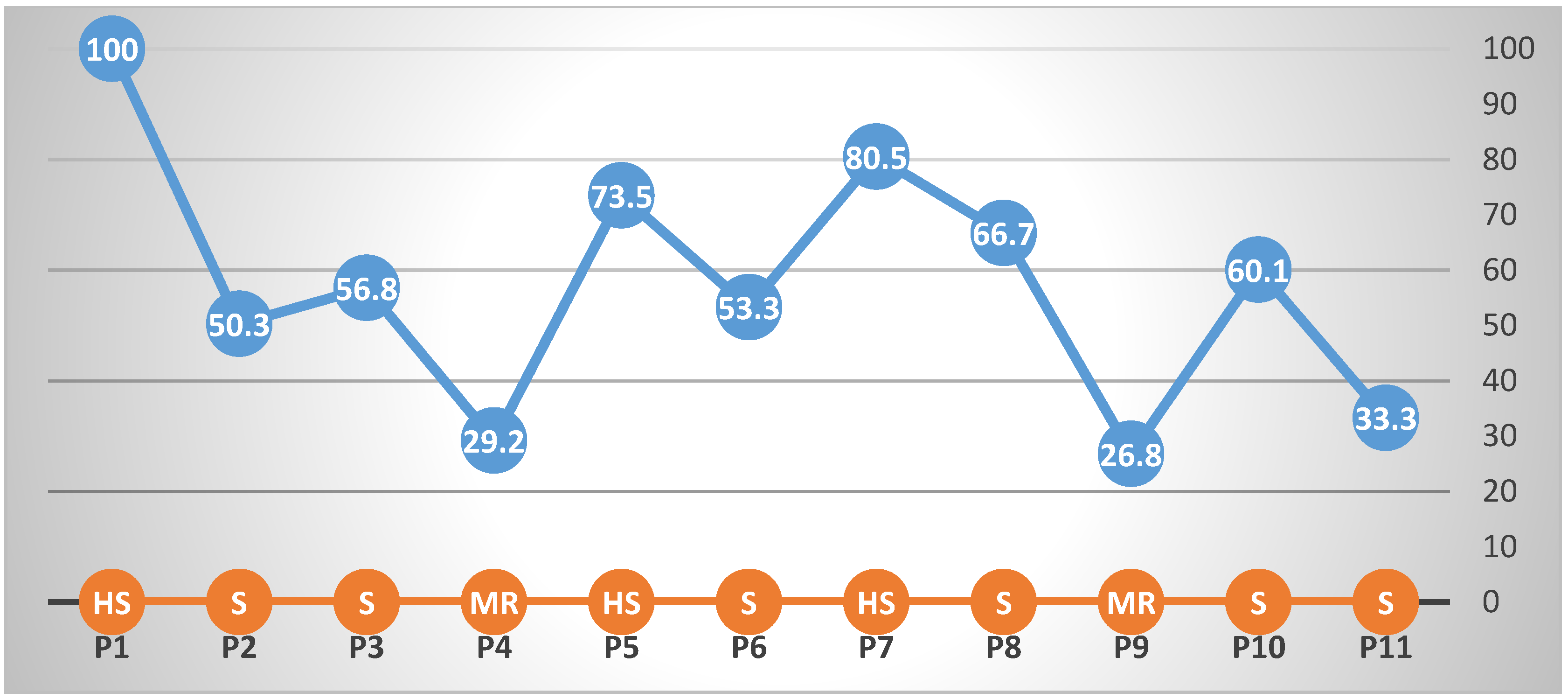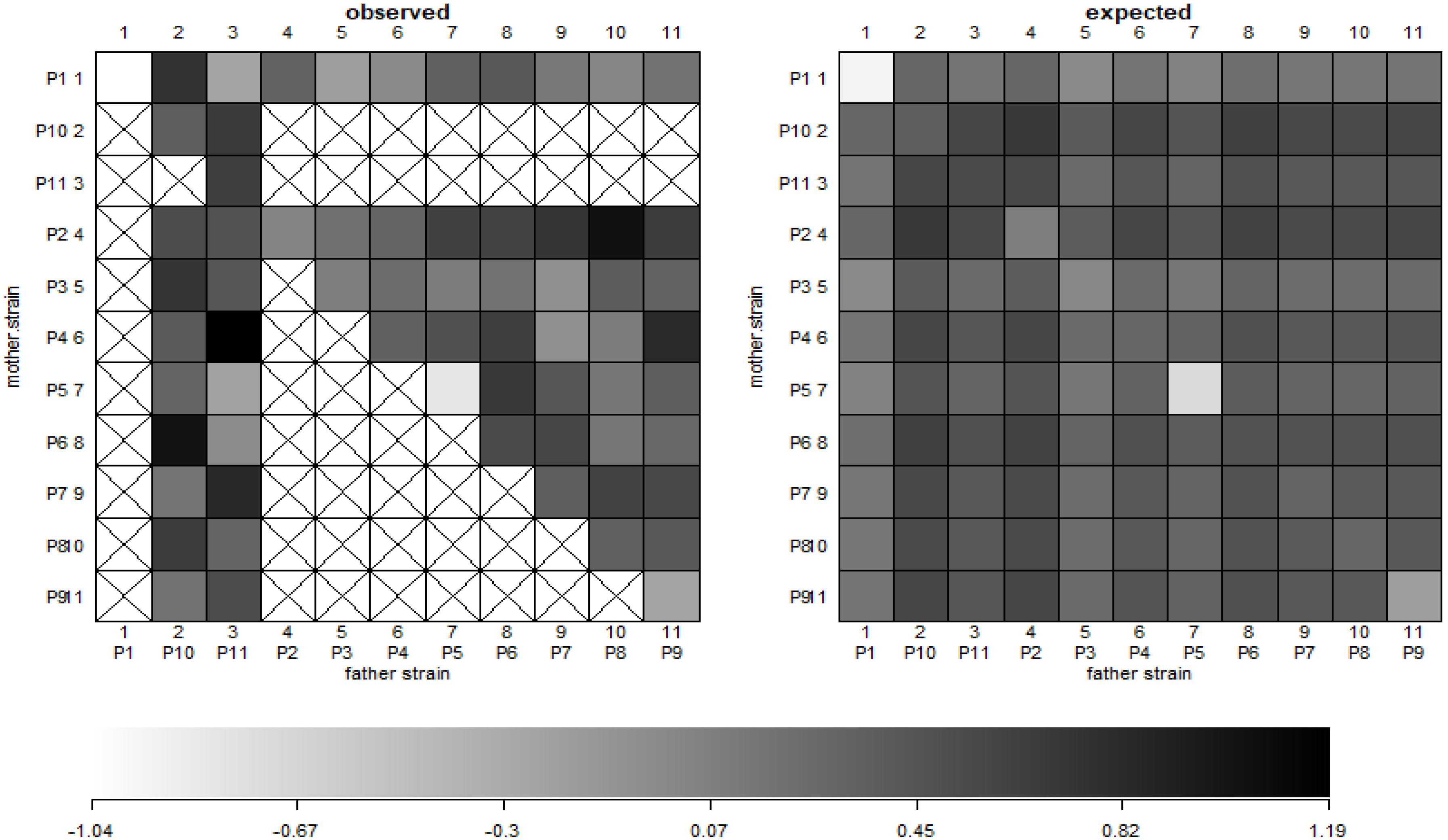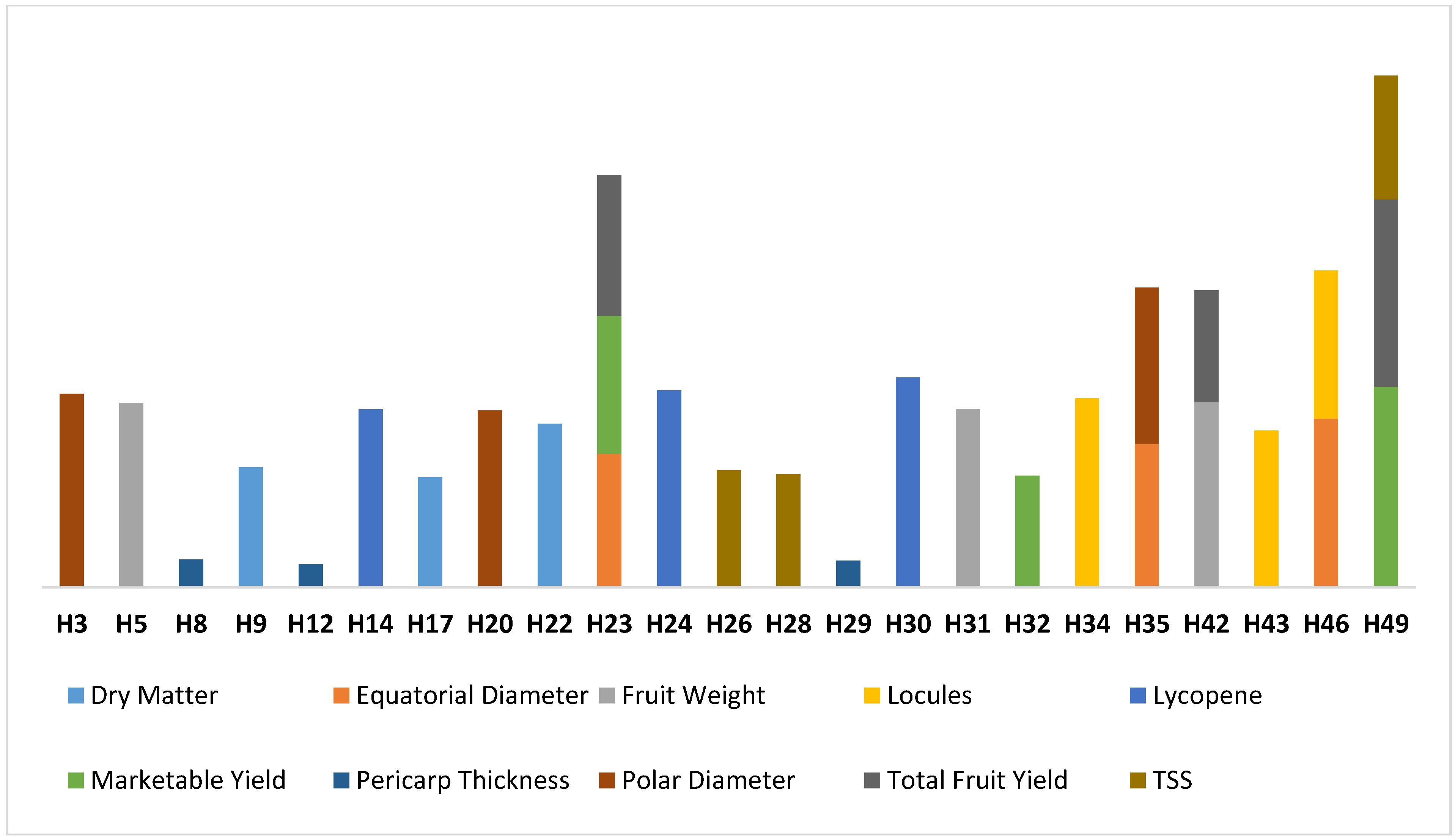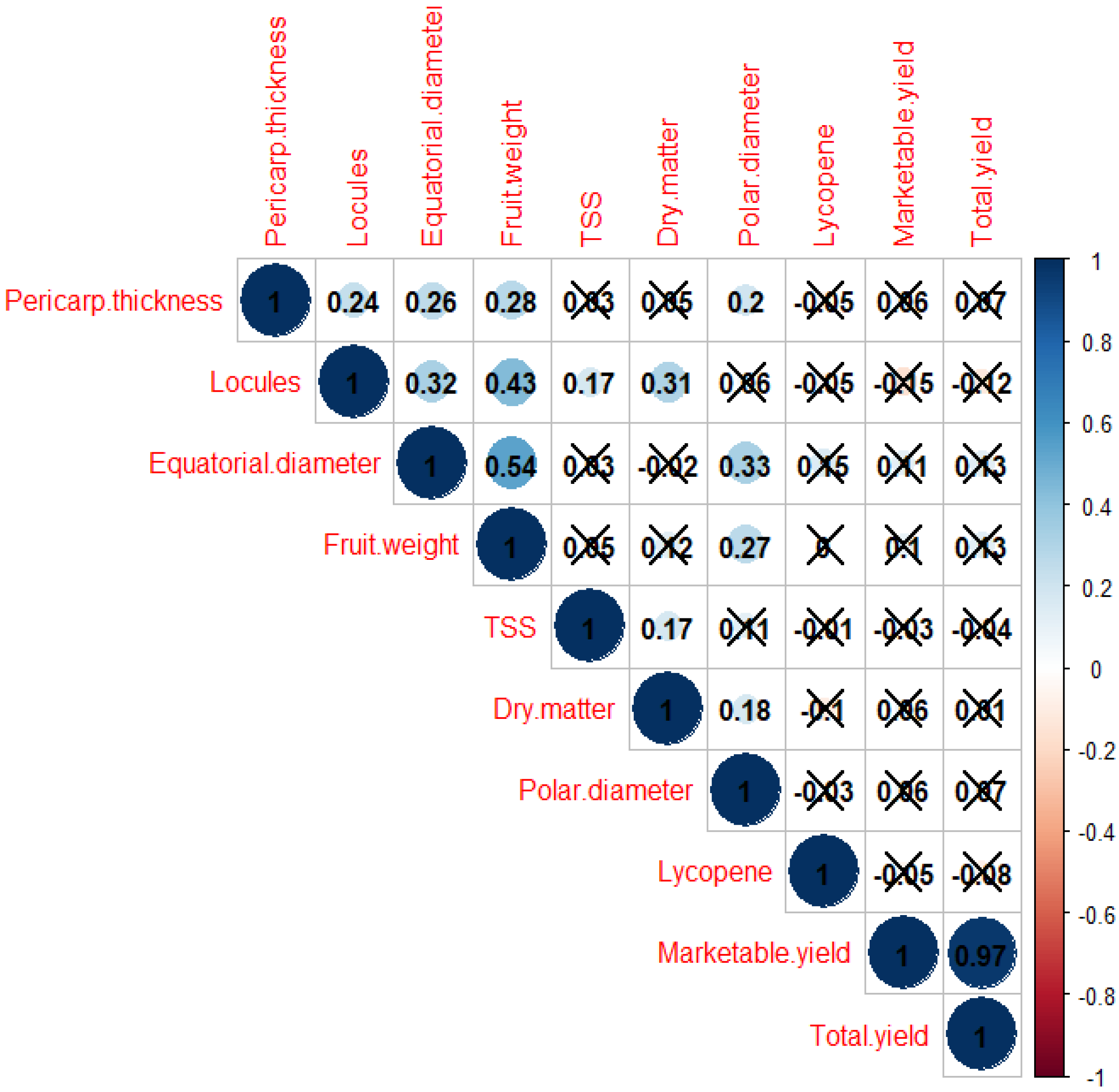Diallel Analysis for Morphological and Biochemical Traits in Tomato Cultivated under the Influence of Tomato Leaf Curl Virus
Abstract
1. Introduction
2. Materials and Methods
2.1. Plant Material and Artificial Screening
2.2. Characterization and Data Analysis
2.3. Bayesian Model-Based Analysis of Total Yield
3. Results and Discussion
3.1. Artificial Screening
3.2. Variation in Parents and Hybrids
3.3. Bayesian Model-Based Estimates and Predictions of Total Yield
3.4. GCA and SCA Estimates
3.5. Correlations
4. Conclusions
Supplementary Materials
Author Contributions
Funding
Acknowledgments
Conflicts of Interest
References
- Kalloo, G. Genetic Improvement of Tomato; Springer Science & Business Media: Berlin, Germany, 2012; ISBN 978-3-642-84275-7. [Google Scholar]
- Víquez-Zamora, M.; Vosman, B.; van de Geest, H.; Bovy, A.; Visser, R.G.; Finkers, R.; van Heusden, A.W. Tomato breeding in the genomics era: Insights from a SNP array. BMC Genom. 2013, 14, 354. [Google Scholar] [CrossRef] [PubMed]
- Hossain, M.A.; Wani, S.H.; Bhattacharjee, S.; Burritt, D.J.; Tran, L.-S.P. Drought Stress Tolerance in Plants, Vol 1: Physiology and Biochemistry; Springer: Berlin, Germany, 2016; ISBN 978-3-319-28899-4. [Google Scholar]
- Jacobsen, S.-E.; Jensen, C.R.; Liu, F. Improving crop production in the arid Mediterranean climate. Field Crop. Res. 2012, 128, 34–47. [Google Scholar] [CrossRef]
- Jensen, C.R.; Battilani, A.; Plauborg, F.; Psarras, G.; Chartzoulakis, K.; Janowiak, F.; Stikic, R.; Jovanovic, Z.; Li, G.; Qi, X.; et al. Deficit irrigation based on drought tolerance and root signalling in potatoes and tomatoes. Agric. Water Manag. 2010, 98, 403–413. [Google Scholar] [CrossRef]
- Gupta, S.K.; Thind, T.S. Disease Problems in Vegetable Production; Scientific Publishers: New Delhi, India, 2012; ISBN 978-93-86347-51-0. [Google Scholar]
- Xu, C.; Sun, X.; Taylor, A.; Jiao, C.; Xu, Y.; Cai, X.; Wang, X.; Ge, C.; Pan, G.; Wang, Q.; et al. Diversity, distribution, and evolution of tomato viruses in China uncovered by small RNA sequencing. J. Virol. 2017, 91, 1–14. [Google Scholar] [CrossRef] [PubMed]
- Picó, B.; Díez, M.J.; Nuez, F. Viral diseases causing the greatest economic losses to the tomato crop. II. The tomato yellow leaf curl virus—A review. Sci. Hortic. 1996, 67, 151–196. [Google Scholar] [CrossRef]
- Saxena, S.; Tiwari, A.K. Begomoviruses: Occurrence and Management in Asia and Africa; Springer: Singapore, 2017; ISBN 978-981-10-5984-1. [Google Scholar]
- Gaikwad, K.A.; Cheema, D.S.; Sharma, A.; Dhaliwal, M.S. Reactioofelitetomato (Solanumly copersicum L.) germplasm against tomato leaf curl virus disease. Acta. Hortic. 2011, 157–161. [Google Scholar] [CrossRef]
- Moriones, E.; Praveen, S.; Chakraborty, S. Tomato leaf curl new delhi virus: An emerging virus complex threatening vegetable and fiber crops. Viruses 2017, 9, 264. [Google Scholar] [CrossRef] [PubMed]
- Sharma, N.; Prasad, M. An insight into plant–Tomato leaf curl New Delhi virus interaction. Nucleus 2017, 60, 335–348. [Google Scholar] [CrossRef]
- Picó, B.; Díez, M.J.; Nuez, F. Evaluation of whitefly-mediated inoculation techniques to screen lycopersicon esculentum and wild relatives for resistance to tomato yellow leaf curl virus. Euphytica 1998, 101, 259–271. [Google Scholar] [CrossRef]
- Singh, R.K.; Rai, N.; Singh, M.; Saha, S.; Singh, S.N. Detection of tomato leaf curl virus resistance and inheritance in tomato (Solanum lycopersicum L.). J. Agric. Sci. 2015, 153, 78–89. [Google Scholar] [CrossRef]
- Díez, M.J.; Nuez, F. Tomato. In Vegetables II; Handbook of Plant Breeding; Springer: New York, NY, USA, 2008; pp. 249–323. ISBN 978-0-387-74108-6. [Google Scholar]
- Kaushik, P.; Andújar, I.; Vilanova, S.; Plazas, M.; Gramazio, P.; Herraiz, F.J.; Brar, N.S.; Prohens, J. Breeding vegetables with increased content in bioactive phenolic acids. Molecules 2015, 20, 18464–18481. [Google Scholar] [CrossRef] [PubMed]
- Arias, R.; Lee, T.-C.; Logendra, L.; Janes, H. Correlation of lycopene measured by HPLC with the L*, a*, b* color readings of a hydroponic tomato and the relationship of maturity with color and lycopene content. J. Agric. Food Chem. 2000, 48, 1697–1702. [Google Scholar] [CrossRef] [PubMed]
- Palozza, P.; Simone, R.E.; Catalano, A.; Mele, M.C. Tomato lycopene and lung cancer prevention: From experimental to human studies. Cancers 2011, 3, 2333–2357. [Google Scholar] [CrossRef] [PubMed]
- Wei, M.Y.; Giovannucci, E.L. Lycopene, Tomato Products, and Prostate Cancer Incidence: A Review and Reassessment in the PSA Screening Era. Available online: https://www.hindawi.com/journals/jo/2012/271063/ (accessed on 1 April 2012).
- Des Marais, D.L.; Hernandez, K.M.; Juenger, T.E. Genotype-by-environment interaction and plasticity: Exploring genomic responses of plants to the abiotic environment. Ann. Rev. Ecol. Evol. Syst. 2013, 44, 5–29. [Google Scholar] [CrossRef]
- Beckles, D.M. Factors affecting the postharvest soluble solids and sugar content of tomato (Solanumly copersicum L.) fruit. Postharvest Biol. Technol. 2012, 63, 129–140. [Google Scholar] [CrossRef]
- Acharya, B.; Dutta, S.; Dutta, S.; Chattopadhyay, A. Breeding tomato for simultaneous improvement of processing quality, fruit yield, and dual disease tolerance. Int. J. Veg. Sci. 2018, 1–17. [Google Scholar] [CrossRef]
- Panthee, D.R.; Perkins-Veazie, P.; Anderson, C.; Ibrahem, R. Diallel analysis for lycopene content in the hybrids derived from different colored parents in tomato. Am. J. Plant Sci. 2015, 6, 1483. [Google Scholar] [CrossRef]
- Shattuck, V.I.; Christie, B.; Corso, C. Principles for Griffing’s combining ability analysis. Genetica 1993, 90, 73–77. [Google Scholar] [CrossRef]
- Griffing, B. Concept of general and specific combining ability in relation to diallel crossing systems. Aust. J. Biol. Sci. 1956, 9, 463–493. [Google Scholar] [CrossRef]
- Hanson, P.M.; Licardo, O.; Hanudin; Wang, J.-F.; Chen, J. Diallel analysis of bacterial wilt resistance in tomato derived from different sources. Plant Dis. 1998, 82, 74–78. [Google Scholar] [CrossRef]
- Kaushik, P.; Plazas, M.; Prohens, J.; Vilanova, S.; Gramazio, P. Diallel genetic analysis for multiple traits in eggplant and assessment of genetic distances for predicting hybrids performance. PLoS ONE 2018, 13, e0199943. [Google Scholar] [CrossRef] [PubMed]
- Do Rêgo, E.R.; do Rêgo, M.M.; Finger, F.L.; Cruz, C.D.; Casali, V.W.D. A diallel study of yield components and fruit quality in chilli pepper (Capsicum baccatum). Euphytica 2009, 168, 275–287. [Google Scholar] [CrossRef]
- Taggar, G.K.; Gill, R.S. Preference of whitefly, Bemisiatabaci, towards black gram genotypes: Role of morphological leaf characteristics. Phytoparasitica 2012, 40, 461–474. [Google Scholar] [CrossRef]
- Toscano, L.C.; Boiça, A.L., Jr.; Leal, A.; Maruyama, W.I. Nonpreference of whitefly for oviposition in tomato genotypes. Sci. Agr. 2002, 59, 677–681. [Google Scholar] [CrossRef]
- Wu, H.X.; Matheson, A.C. Analysis of half-diallel mating design with missing crosses: Theory and SAS program for testing and estimating GCA and SCA fixed effects. Silvae Genet. 2000, 49, 130–137. [Google Scholar]
- Xiang, B.; Li, B. A new mixed analytical method for genetic analysis of diallel data. Can. J. For. Res. 2001, 31, 2252–2259. [Google Scholar] [CrossRef]
- Greenberg, A.J.; Hackett, S.R.; Harshman, L.G.; Clark, A.G. A hierarchical bayesian model for a novel sparse partial diallel crossing design. Genetics 2010, 185, 361–373. [Google Scholar] [CrossRef] [PubMed]
- Lenarcic, A.B.; Svenson, K.L.; Churchill, G.A.; Valdar, W. A general bayesian approach to analyzing diallel crosses of inbred strains. Genetics 2012, 190, 413–435. [Google Scholar] [CrossRef] [PubMed]
- Turner, S.D.; Maurizio, P.L.; Valdar, W.; Yandell, B.S.; Simon, P.W. Dissecting the genetic architecture of shoot growth in carrot (Daucus carota L.) using a diallel mating design. Genes Genom. Genet. 2018, 8, 411–426. [Google Scholar] [CrossRef] [PubMed]
- Banerjee, M.K. Kalloo Inheritance of tomato leaf curl virus resistance in Lycopersicon hirsutum f. Glabratum. Euphytica 1987, 36, 581–584. [Google Scholar] [CrossRef]
- Sharma, O.P.; Mahajan, R.; Singh, S. Field reaction of some root-knot resistant tomato varieties and hybrids to tobacco mosaic and tobacco leaf curl viruses. Indian J. Mycol. Plant Pathol. 1984, 14, 148–150. [Google Scholar]
- Maria Alda, L.; Gogoaşă, I.; Bordean, D.-M.; Gergen, I.; Alda, S.; Moldovan, C.; Niţă, L. Lycopene content of tomatoes and tomato products. J. Agroaliment. Proc. Technol. 2009, 15, 540–542. [Google Scholar]
- Rodríguez, F.; Alvarado, G.; Pacheco, Á.; Crossa, J.; Burgueño, J. AGD-R (Analysis of Genetic Designs with R for Windows) Version 4.0. Available online: https://data.cimmyt.org/dataset.xhtml?persistentId=hdl:11529/10202 (accessed on 11 June 2015).
- Wei, T.; Simko, V.; Levy, M.; Xie, Y.; Jin, Y.; Zemla, J. Corrplot: Visualization of a Correlation Matrix. Available online: https://github.com/taiyun/corrplot (accessed on 17 October 2017).
- Peterson, B.G.; Carl, P.; Boudt, K.; Bennett, R.; Ulrich, J.; Zivot, E.; Cornilly, D.; Hung, E.; Lestel, M.; Balkissoon, K.; et al. Performance Analytics: Econometric Tools for Performance and Risk Analysis. Available online: https://github.com/braverock/PerformanceAnalytics (accessed on 2 March 2018).
- Lapidot, M.; Ben-Joseph, R.; Cohen, L.; Machbash, Z.; Levy, D. Development of a scale for evaluation of tomato yellow leaf curl virus resistance level in tomato plants. Phytopathology 2006, 96, 1404–1408. [Google Scholar] [CrossRef] [PubMed]
- Ambawat, S.; Sharma, P.; Yadav, N.R.; Yadav, R.C. MYB transcription factor genes as regulators for plant responses: An overview. Physiol. Mol. Biol. Plants 2013, 19, 307–321. [Google Scholar] [CrossRef] [PubMed]
- Gaikwad, K.A.; Sharma, A.; Cheema, D.S. Molecular detection and characterization of leaf curl virus infecting tomato in punjab, India. Acta. Hortic. 2011, 153–156. [Google Scholar] [CrossRef]
- Lapidot, M.; Friedmann, M.; Lachman, O.; Yehezkel, A.; Nahon, S.; Cohen, S.; Pilowsky, M. Comparison of resistance level to tomato yellow leaf curl virus among commercial cultivars and breeding lines. Plant Dis. 1997, 81, 1425–1428. [Google Scholar] [CrossRef]
- Pérez-De-Castro, A.; Campos, G.; Julián, O.; Dueñas, F.; Álvarez, M.; Martínez-Zubiaur, Y.; Díez, M.J. Evaluation under diverse conditions of a differential host reaction scale to tomato yellow leaf curl virus in tomato. Phytopathol. Mediterr. 2017, 56, 50–61. [Google Scholar] [CrossRef]
- Fereres, A.; Peñaflor, M.F.G.V.; Favaro, C.F.; Azevedo, K.E.X.; Landi, C.H.; Maluta, N.K.P.; Bento, J.M.S.; Lopes, J.R.S. Tomato infection by whitefly-transmitted circulative and non-circulative viruses induce contrasting changes in plant volatiles and vector behaviour. Viruses 2016, 8, 225. [Google Scholar] [CrossRef] [PubMed]
- Channarayappa, C.; Shivashankar, G.; Muniyappa, V.; Frist, R.H. Resistance of lycopersicon species to bemisiatabaci, a tomato leaf curl virus vector. Can. J. Bot. 1992, 70, 2184–2192. [Google Scholar] [CrossRef]
- Farzane, A.; Nemati, H.; Aroiee, H.; Mirshamsi, A.; Vahdati, N. The estimate of combining ability and heterosis for yield and yield components in tomato (Lycopersicon esculentum Mill.). J. Biol. Environ. Sci. 2012, 6, 129–134. [Google Scholar]
- Shalaby, T.A. Mode of gene action, heterosis and inbreeding depression for yield and its components in tomato (Solanumly copersicum L.). Sci. Hortic. 2013, 164, 540–543. [Google Scholar] [CrossRef]
- Shankar, A.; Reddy, R.V.S.K.; Sujatha, M.; Pratap, M. Combining ability and gene action studies for yield and yield contributing traits in tomato (Solanumly copersicum L.). Helix 2012, 6, 431–435. [Google Scholar]
- Govindarasu, P.; Muthukrishnan, C.R.; Irulappan, I. Combining-ability for yield and its components in tomato. Sci. Hortic. 1981, 14, 125–130. [Google Scholar] [CrossRef]
- Dufera, J.T.; Mohammed, W.; Hussien, S.; Kumar, V. Genetic analysis for fruit yield and quality attributes in some processing and fresh market tomato genotypes. Int. J. Veg. Sci. 2018, 24, 227–235. [Google Scholar] [CrossRef]
- Kumar, R.; Srivastava, K.; Singh, N.P.; Vasistha, N.K.; Singh, R.K.; Singh, M.K. Combining ability analysis for yield and quality traits in tomato (Solanumly copersicum L.). J. Agric. Sci. 2013, 5, 213–218. [Google Scholar] [CrossRef]
- Bleeker, P.M.; Diergaarde, P.J.; Ament, K.; Guerra, J.; Weidner, M.; Schütz, S.; de Both, M.T.J.; Haring, M.A.; Schuurink, R.C. The role of specific tomato volatiles in tomato-whitefly interaction. Plant Physiol. 2009, 151, 925–935. [Google Scholar] [CrossRef] [PubMed]
- Maluta, N.K.P.; Fereres, A.; Lopes, J.R.S. Settling preferences of the whitefly vector Bemisiatabaci on infected plants varies with virus family and transmission mode. Entomol. Exp. Appl. 2017, 165, 138–147. [Google Scholar] [CrossRef]
- Crowley, J.J.; Kim, Y.; Lenarcic, A.B.; Quackenbush, C.R.; Barrick, C.J.; Adkins, D.E.; Shaw, G.S.; Miller, D.R.; de Villena, F.P.-M.; Sullivan, P.F.; et al. Genetics of adverse reactions to haloperidol in a mouse diallel: A drug-placebo experiment and Bayesian causal analysis. Genetics 2014, 196, 321–347. [Google Scholar] [CrossRef] [PubMed]
- Lunt, K.A.; Roux, C.Z.; Blokpoel, I.; Booyse, M. Inheritance of flavour in six tomato (Lycopersicone sculentum) varieties. S. Afr. J. Plant Soil 1999, 16, 113–117. [Google Scholar] [CrossRef]
- Pandiarana, N.; Chattopadhyay, A.; Seth, T.; Shende, V.D.; Dutta, S.; Hazra, P. Heterobeltiosis, potence ratio and genetic control of processing quality and disease severity traits in tomato. N. Z. J. Crop Hortic. Sci. 2015, 43, 282–293. [Google Scholar] [CrossRef]
- Souza, L.M.D.; Paterniani, M.E.A.; Melo, P.C.T.D.; Melo, A.M.D. Diallel cross among fresh market tomato inbreeding lines. Hortic. Bras. 2012, 30, 246–251. [Google Scholar] [CrossRef]
- Kumar, D.; Kumar, R.; Kumar, S.; Bhardwaj, M.L.; Thakur, M.C.; Kumar, R.; Thakur, K.S.; Dogra, B.S.; Vikram, A.; Thakur, A.; et al. Genetic variability, correlation and path coefficient analysis in tomato. Int. J. Veg. Sci. 2013, 19, 313–323. [Google Scholar] [CrossRef]
- De Souza, L.M.; Melo, P.C.T.; Luders, R.R.; Melo, A.M. Correlations between yield and fruit quality characteristics of fresh market tomatoes. Hortic. Bras. 2012, 30, 627–631. [Google Scholar] [CrossRef]
- Rao, E.S.; Kadirvel, P.; Symonds, R.C.; Ebert, A.W. Relationship between survival and yield related traits in Solanum pimpinellifolium under salt stress. Euphytica 2013, 190, 215–228. [Google Scholar] [CrossRef]







| P2 | P3 | P4 | P5 | P6 | P7 | P8 | P9 | P10 | P11 | |
|---|---|---|---|---|---|---|---|---|---|---|
| P1 | H1 | H2 | H3 | H4 | H5 | H6 | H7 | H8 | H9 | H10 |
| P2 | H11 | H12 | H13 | H14 | H15 | H16 | H17 | H18 | H19 | |
| P3 | H20 | H21 | H22 | H23 | H24 | H25 | H26 | H27 | ||
| P4 | H28 | H29 | H30 | H31 | H32 | H33 | H34 | |||
| P5 | H35 | H36 | H37 | H38 | H39 | H40 | ||||
| P6 | H41 | H42 | H43 | H44 | H45 | |||||
| P7 | H46 | H47 | H48 | H49 | ||||||
| P8 | H50 | H51 | H52 | |||||||
| P9 | H53 | H54 | ||||||||
| P10 | H55 | |||||||||
| P11 |
| Source of Variation | Genotypes a | GCA a | SCA a | Error | Baker Ratio | h2 | H2 |
|---|---|---|---|---|---|---|---|
| Degree of freedom | 65 | 10 | 55 | 65 | |||
| Dry matter | 0.38 *** | 0.66 *** | 0.33 *** | 0.11 | 0.80 | 0.22 | 0.95 |
| Equatorial diameter | 0.68 *** | 0.87 *** | 0.65 *** | 0.01 | 0.73 | 0.17 | 0.97 |
| Fruit weight | 964.97 *** | 2755.90 *** | 639.35 *** | 31.90 | 0.90 | 0.38 | 0.94 |
| Locules | 0.87 *** | 1.48 *** | 0.76 *** | 0.02 | 0.80 | 0.22 | 0.96 |
| Lycopene | 1.58 *** | 1.91 *** | 1.51 *** | 0.01 | 0.72 | 0.16 | 0.95 |
| Marketable yield | 0.55 *** | 0.71 *** | 0.52 *** | 0.01 | 0.73 | 0.17 | 0.96 |
| Pericarp thickness | 0.03 *** | 0.05 *** | 0.03 *** | 0.07 | 0.77 | 0.20 | 0.95 |
| Polar diameter | 0.83 *** | 0.55 *** | 0.88 *** | 0.01 | 0.56 | 0.10 | 0.97 |
| Total yield | 0.56 *** | 0.91 *** | 0.50 *** | 0.01 | 0.78 | 0.22 | 0.96 |
| TSS | 0.35 *** | 0.28 *** | 0.36 *** | 0.01 | 0.61 | 0.10 | 0.94 |
| Diallel Inheritance Class | Mean | 2.50% | 25% | 50% | 75% | 97.50% |
|---|---|---|---|---|---|---|
| Inbred penalty (B) | 6.76 | 0.11 | 4.09 | 6.42 | 9.10 | 15.22 |
| Additive (a) | 23.97 | 13.71 | 20.28 | 23.95 | 27.58 | 34.64 |
| Inbred deviation (b) | 10.31 | 2.33 | 7.09 | 10.03 | 13.16 | 20.25 |
| Total variance explained | 41.03 | 30.31 | 37.45 | 41.18 | 44.72 | 51.15 |
| Unexplained variance | 58.97 | 48.85 | 55.28 | 58.82 | 62.55 | 69.69 |
| Parent | Dry Matter a | Equatorial Diameter a | Fruit Weight a | Locules a | Lycopene a | Marketable Yield a | Pericarp Thickness a | Polar Diameter a | Total Yield a | TSS a |
|---|---|---|---|---|---|---|---|---|---|---|
| P1 | 0.091 *** | −0.201 *** | −12.458 *** | −0.022 *** | −0.121 *** | −0.333 *** | −0.009 ns | 0.061 * | −0.366 *** | 0.152 *** |
| P2 | 0.346 *** | −0.181 *** | 6.773 *** | 0.355 *** | −0.415 *** | 0.188 *** | 0.003 ns | −0.020 ns | 0.151 *** | −0.048 * |
| P3 | −0.105 *** | −0.098 *** | −15.122 *** | −0.298 *** | 0.454 *** | −0.133 *** | −0.007 ns | −0.061 * | −0.206 *** | 0.010 ns |
| P4 | −0.121 *** | 0.273 *** | 8.495 *** | 0.261 *** | −0.086 ** | 0.048 ns | −0.002 ns | 0.025 ns | 0.089** | −0.168 *** |
| P5 | −0.067 ** | 0.137 *** | 9.596 *** | −0.085 ** | −0.061 * | −0.180 *** | −0.016 * | 0.177 *** | −0.207 *** | 0.034 ns |
| P6 | −0.178 *** | 0.041 ns | −0.690 ns | −0.273 *** | 0.427 *** | 0.161 *** | −0.038 *** | −0.257 *** | 0.154 *** | −0.071 ** |
| P7 | 0.021 ns | 0.195 *** | 7.770 *** | −0.089 ** | 0.106 *** | 0.012 ns | 0.018 * | 0.263 *** | 0.032 ns | 0.023 ns |
| P8 | 0.170 *** | 0.168 *** | 8.453 *** | 0.350 *** | −0.169 *** | 0.018 ns | 0.115 *** | −0.039 ns | 0.023 ns | 0.195 *** |
| P9 | 0.033 ns | −0.045 ns | 4.867 *** | 0.126 *** | 0.213 *** | −0.070 ** | 0.029 *** | −0.178 *** | −0.050 * | −0.011 ns |
| P10 | −0.185 *** | 0.007 ns | −0.081 ns | −0.120 *** | −0.215 *** | 0.141 *** | −0.035 *** | 0.060 * | 0.215 *** | −0.098 *** |
| P11 | −0.003 ns | −0.296 *** | −17.605 *** | −0.205 *** | −0.132 *** | 0.148 *** | −0.058 *** | −0.032 ns | 0.164 *** | −0.019 ns |
© 2018 by the authors. Licensee MDPI, Basel, Switzerland. This article is an open access article distributed under the terms and conditions of the Creative Commons Attribution (CC BY) license (http://creativecommons.org/licenses/by/4.0/).
Share and Cite
Kaushik, P.; Dhaliwal, M.S. Diallel Analysis for Morphological and Biochemical Traits in Tomato Cultivated under the Influence of Tomato Leaf Curl Virus. Agronomy 2018, 8, 153. https://doi.org/10.3390/agronomy8080153
Kaushik P, Dhaliwal MS. Diallel Analysis for Morphological and Biochemical Traits in Tomato Cultivated under the Influence of Tomato Leaf Curl Virus. Agronomy. 2018; 8(8):153. https://doi.org/10.3390/agronomy8080153
Chicago/Turabian StyleKaushik, Prashant, and Major Singh Dhaliwal. 2018. "Diallel Analysis for Morphological and Biochemical Traits in Tomato Cultivated under the Influence of Tomato Leaf Curl Virus" Agronomy 8, no. 8: 153. https://doi.org/10.3390/agronomy8080153
APA StyleKaushik, P., & Dhaliwal, M. S. (2018). Diallel Analysis for Morphological and Biochemical Traits in Tomato Cultivated under the Influence of Tomato Leaf Curl Virus. Agronomy, 8(8), 153. https://doi.org/10.3390/agronomy8080153






